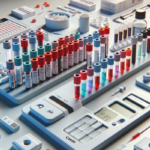Essential Insights into Blood Test Lab Risks for Enhanced Patient Safety
Blood tests are indispensable tools for diagnosing and monitoring a variety of health conditions, yet they come with inherent risks that can profoundly influence patient outcomes. It is essential for both patients and healthcare professionals to fully understand the intricate dynamics of blood test lab risks. By shedding light on these often-overlooked dangers, we can navigate the complexities of laboratory testing more effectively, ensuring that patient safety remains at the forefront of healthcare practices.
Identifying and Understanding the Spectrum of Laboratory Errors

The realm of laboratory testing is profoundly complex, where even minor errors can spiral into catastrophic consequences for patients. Laboratory errors can manifest through a variety of channels, including pre-analytical mistakes such as sample collection and handling, as well as analytical errors that occur during the testing phase. For instance, misdiagnoses can arise from improperly labelled samples, contamination, or the selection of inappropriate tests, leading to dire repercussions for patient care and treatment decisions.
If a blood sample is not processed within the stipulated timeframe, the integrity of the results can be compromised, resulting in false positives or negatives that ultimately affect treatment pathways. Moreover, erroneous interpretations of test results can arise when laboratories fail to adhere to established protocols, highlighting the critical importance of maintaining stringent standards in blood testing to protect patients from potential harm.
Assessing the Role of Human Error in Laboratory Mistakes
Human error is an unavoidable reality in any professional setting, and laboratories are no exception to this rule. The risks associated with blood tests and mistakes made by laboratory technicians can lead to significant adverse outcomes for patients. Such errors may stem from various factors, including fatigue, insufficient training, or simple oversight. For example, a technician might mislabel a blood sample or fail to adhere to standard operating procedures, resulting in inaccurate test results that could jeopardize patient health.
Furthermore, communication breakdowns among laboratory personnel can exacerbate these challenges. If crucial information about a patient's medical history is not effectively conveyed, it may negatively impact the interpretation of lab results. To mitigate these risks, it is imperative for laboratories to foster a culture centered on safety, encouraging team members to double-check their work and maintain open communication regarding potential issues that could arise during testing.
Recognizing the Impact of Technological Failures on Test Accuracy
While advancements in technology have revolutionized laboratory practices, they are not immune to failures that can compromise test accuracy. Equipment malfunctions can drastically skew the results of blood tests, leading to misdiagnoses and inappropriate treatment strategies. For example, a malfunctioning analyser may produce inconsistent or erroneous results, necessitating additional tests or unnecessary interventions that could complicate patient care.
Moreover, an overreliance on technology can cultivate a misleading sense of security within laboratories. To ensure optimal performance, it is critical for laboratories to regularly maintain and calibrate their equipment. Additionally, establishing robust backup systems can aid in identifying errors before they adversely impact patient care. By acknowledging the potential for technological failures, laboratories can proactively implement measures that protect their processes and ultimately enhance patient safety.
Delving into the Legal and Ethical Aspects of Blood Test Lab Risks

As the complexities of blood test lab risks become more apparent, so too does the need to understand the legal and ethical frameworks that govern these issues. Patients have the right to be informed about their rights and the recourse available to them should they fall victim to laboratory mistakes or errors.
Understanding Your Rights as a Patient in Medical Testing
Patients are entitled to receive a specific standard of care when it comes to medical testing. This encompasses the right to accurate test results and clear communication regarding potential risks involved. Patients should be well-informed about their rights to seek clarification and hold laboratories accountable when faced with lab errors, ensuring that they are not left vulnerable to the consequences of negligence.
Furthermore, patients bear the responsibility of providing accurate and comprehensive information related to their medical history and any medications they are currently taking. This information can significantly influence test results and help mitigate the risks associated with blood testing. By fostering a collaborative relationship with healthcare providers, patients can actively contribute to their safety and overall care.
Exploring Legal Options Following Misdiagnosis from Lab Errors
When blood test lab risks culminate in misdiagnosis, patients may have legal avenues available to them. It is crucial for affected individuals to understand the appropriate steps to take in such situations. Patients should meticulously document all communications with healthcare providers and gather evidence related to the misdiagnosis, including medical records and test results that support their case.
Consulting with a legal professional who specializes in medical malpractice can provide invaluable guidance on pursuing a claim. It is essential to demonstrate that the laboratory or healthcare provider failed to meet the accepted standard of care, which ultimately led to harm. While navigating this complex process may appear daunting, it is vital for patients to hold those responsible for lab errors accountable for their actions.
Ethical Considerations in Reporting Laboratory Errors

Ethics plays a pivotal role in fostering transparency within laboratory operations. Healthcare providers and laboratories have a moral obligation to disclose errors to patients, ensuring they are aware of the potential impacts on their health and treatment. This openness not only builds trust between patients and providers but also promotes a culture of accountability within the laboratory setting.
While reporting lab errors may be uncomfortable for staff, it is essential for advancing laboratory practices and preventing future mistakes. Laboratories should establish clear protocols for error reporting and cultivate an environment where employees feel empowered to raise concerns about issues without fear of retribution. By prioritizing ethical considerations, labs can significantly enhance patient safety and contribute to a more resilient healthcare system.
Implementing Comprehensive Strategies to Mitigate Blood Test Lab Risks
Addressing the multifaceted nature of blood test lab risks requires a holistic approach. By deploying effective mitigation strategies, laboratories can dramatically decrease the likelihood of errors and bolster the reliability of test results.
Establishing Robust Quality Control Protocols
Quality control forms the cornerstone of any reputable laboratory. By implementing stringent quality control measures, laboratories can minimize errors at every stage of the testing process. This includes regular equipment calibration, proficiency testing, and strict adherence to established standard operating procedures as integral components of a comprehensive quality control program.
Moreover, laboratories should establish a continuous monitoring system to identify trends and potential issues at an early stage. By analyzing data on error rates and implementing timely corrective actions, labs can foster a culture of ongoing improvement that prioritizes patient safety and satisfaction.
The Vital Importance of Staff Training and Certification
A well-trained workforce is fundamental in minimizing blood test lab risks. Ensuring that laboratory personnel receive adequate training and certification can significantly improve the accuracy and reliability of test results. Regular training sessions and workshops are essential for keeping staff informed about the latest protocols and technologies in the field.
Encouraging a culture of learning and development also fosters a sense of ownership among staff members regarding their roles and responsibilities. When laboratory personnel feel confident in their skills and knowledge, they are more likely to adhere to best practices, which ultimately reduces the incidence of errors and enhances overall patient care.
Leveraging Technology to Enhance Blood Testing Accuracy
Embracing cutting-edge technological advancements can greatly enhance the precision of blood tests. Automated systems, for instance, can significantly reduce human error by streamlining procedures and minimizing the need for manual input throughout the testing process. By incorporating technology into laboratory practices, labs can achieve a higher level of accuracy in their testing protocols.
Additionally, utilizing data analytics within laboratory operations allows for more informed decision-making. By examining trends and patterns in test results, laboratories can identify areas for improvement and implement targeted strategies to mitigate risks effectively. The future of laboratory testing hinges on successfully integrating human expertise with innovative technological solutions.
Understanding the Financial Implications of Blood Test Lab Risks
The repercussions of blood test lab risks extend beyond patient health, carrying significant financial implications for healthcare providers, patients, and the healthcare system as a whole. Understanding these costs is vital for all stakeholders involved in the healthcare process.
The Economic Impact on Healthcare Providers
Laboratories and hospitals can face substantial economic consequences stemming from lab errors. Misdiagnoses can lead to unnecessary treatments, prolonged hospital admissions, and additional testing, all of which contribute to elevated healthcare costs. Furthermore, the reputational damage associated with a history of errors may deter patients from seeking care at specific facilities, further exacerbating the financial strain.
To mitigate these costs, healthcare providers should prioritize investments in quality assurance programs and comprehensive staff training. By focusing on patient safety and reducing error rates, laboratories can enhance their financial sustainability while simultaneously improving patient outcomes and trust in their services.
Navigating Insurance and Liability Implications
Insurance coverage plays a critical role in managing blood test lab risks. Laboratories must navigate the complexities of liability insurance, which can become contentious in cases of misdiagnosis or lab errors. Understanding the nuances of insurance coverage can better equip laboratories to prepare for potential legal challenges and claims.
In instances where lab errors lead to patient harm, individuals may seek compensation through their insurance or pursue legal action against the accountable parties. Laboratory managers must ensure they maintain adequate insurance coverage to protect against these risks and effectively address any claims that may arise.
Assessing Financial Burdens on Patients
Patients can experience significant financial challenges resulting from blood test lab risks. Misdiagnoses may lead to unnecessary treatments and follow-up tests, which can escalate out-of-pocket expenses significantly. Additionally, patients may face increased premiums or deductibles if their insurance rates rise due to lab errors affecting their healthcare journey.
To alleviate these financial pressures, patients should proactively seek to understand their insurance coverage and advocate for transparent communication with their healthcare providers. By doing so, they can make informed choices that ultimately protect their financial well-being and ensure they receive the care they need.
Gaining Insights Through Real-World Case Studies on Blood Test Lab Risks
Examining real-world case studies that involve blood test lab risks provides essential insights into the potential consequences of lab errors and underscores the importance of implementing effective mitigation strategies.
Analyzing High-Profile Incidents and Their Consequences
Noteworthy instances of lab errors have drawn public scrutiny, highlighting the severe repercussions that can arise from blood test lab risks. For example, one prominent case involved a laboratory that reported inaccurate results for cancer markers, leading to incorrect diagnoses and unnecessary treatments for several patients. The aftermath of such incidents often entails not only a loss of trust among patients but also significant legal ramifications for the laboratory involved.
These cases serve as stark reminders of the necessity for maintaining rigorous standards and transparency in laboratory practices. They prompt a reevaluation of protocols and encourage laboratories to adopt more stringent quality control measures to prevent similar occurrences in the future.
Learning from Successful Initiatives in Error Reduction
Conversely, there are also success stories from laboratories that have effectively decreased their error rates through targeted initiatives. By investing in staff training, implementing quality control measures, and utilizing innovative technology, these labs have significantly improved their accuracy and reliability.
For instance, one laboratory that introduced an automated sample tracking system experienced a marked reduction in mislabeled specimens and other pre-analytical errors. Such success stories highlight the potential for advancement within the laboratory industry and inspire others to enhance their practices for the benefit of patient care.
The Critical Role of Public Reporting and Transparency in Laboratories
Publicly reporting lab error rates can substantially enhance laboratory practices. By making this data accessible, laboratories are held accountable for their performance, fostering a culture of transparency and continuous improvement.
Patients stand to gain significantly from this transparency, empowering them to make informed choices about where to seek care. When patients are aware of a laboratory's track record, they can advocate for their safety and demand higher standards of care in their healthcare experiences.
The Transformative Role of Technology in Reducing Blood Test Lab Risks
As technology continues to evolve, the potential for reducing blood test lab risks grows exponentially. Embracing these innovations can lead to more accurate and reliable testing outcomes for patients.
The Automation Revolution in Blood Testing
Automation has dramatically transformed the landscape of laboratory testing by significantly reducing the risk of human error. Automated systems streamline processes from sample collection to analysis, drastically minimizing the chances of mistakes that can occur during manual handling.
For instance, automated pipetting systems provide precise measurements, while robotic systems can efficiently process samples, alleviating the workload on laboratory staff. By integrating automation into testing procedures, laboratories can enhance both accuracy and efficiency, ultimately improving patient safety and care.
The Integration of AI and Machine Learning to Improve Lab Diagnostics
The incorporation of artificial intelligence (AI) and machine learning into laboratory diagnostics holds tremendous potential. These technologies can analyze vast datasets to uncover patterns and anomalies that may elude human technicians.
AI-driven algorithms can assist in interpreting complex test results, leading to more accurate diagnoses and a reduction in errors. As these technologies continue to evolve, they are expected to play an increasingly significant role in enhancing the reliability of blood tests and overall laboratory practices.
Emerging Trends Shaping the Future of Laboratory Technology
Several emerging technologies promise to further minimize blood test lab risks. Innovations such as point-of-care testing, which allows for immediate results at the care site, are gaining popularity and acceptance. This approach not only enhances patient convenience but also minimizes the risks associated with sample transport and processing.
Additionally, advancements in biosensors and molecular diagnostics have the potential to revolutionize the accuracy of blood testing methodologies. By staying attuned to these trends, laboratories can position themselves at the forefront of innovation and significantly improve patient safety.
Addressing Patient Concerns About Blood Test Lab Risks
Patients frequently harbor concerns regarding the safety and accuracy of blood testing. Effectively addressing these worries is vital for establishing trust and fostering a collaborative healthcare experience.
Identifying and Overcoming Common Fears and Misconceptions
Many patients voice concerns about the accuracy of blood tests, fearing that errors may lead to misdiagnoses or inappropriate treatments. Additionally, worries about potential risks associated with blood draws, such as infection or excessive bruising, can further escalate anxiety surrounding the testing process.
By educating patients about the stringent protocols and safeguards implemented by laboratories, healthcare providers can help alleviate these fears. Providing clear information about the testing process and the measures in place to ensure accuracy and safety can instill confidence in patients, empowering them to engage in their healthcare journey.
Effective Communication Strategies for Laboratories to Build Trust
Clear and open communication is paramount in addressing patient concerns surrounding blood test lab risks. Laboratories should prioritize transparency, ensuring that patients receive timely updates about their test results and any potential issues that may arise during the testing process.
Moreover, training staff in effective communication techniques can significantly enhance the patient experience. By fostering a culture of empathy and understanding, laboratories can develop stronger relationships with patients, ultimately improving trust and satisfaction within the healthcare environment.
The Essential Role of Patient Education in Risk Mitigation
Empowering patients with knowledge about blood test lab risks is crucial for promoting safety and effective care. Informed patients are more likely to advocate for themselves and ask pertinent questions regarding their health and treatment plans.
Laboratories can implement educational initiatives designed to inform patients about the testing process, potential risks, and their rights. By equipping patients with the necessary information, labs can foster a healthcare environment that prioritizes safety and collaboration.
Understanding Regulatory Frameworks Governing Blood Test Lab Risks
The regulatory frameworks that govern laboratory practices play a vital role in shaping the landscape of blood test lab risks. Understanding these regulations is essential for ensuring compliance and enhancing patient safety across healthcare settings.
Complying with National and International Standards for Safety
Laboratories are required to adhere to a variety of national and international standards that are designed to ensure safety and quality in testing procedures. Regulations established by organizations such as the Clinical Laboratory Improvement Amendments (CLIA) in the United States and the International Organization for Standardization (ISO) provide essential guidelines that laboratories must follow to maintain the highest standards of practice.
These standards encompass diverse aspects of laboratory operations, including personnel qualifications, equipment calibration, and quality control measures. By diligently adhering to these regulations, laboratories can bolster their credibility and improve overall patient outcomes.
The Impact of Regulatory Compliance on Laboratory Efficiency
Compliance with regulatory standards not only protects patients but also has a significant influence on laboratory operations. Facilities that prioritize adherence to regulations often experience improved operational efficiency and reduced error rates. Additionally, regulatory compliance fosters a culture of accountability among staff members, motivating them to uphold high standards of practice.
Regular audits and assessments can assist laboratories in identifying areas for improvement and ensuring ongoing compliance with established regulations. By committing to these standards, laboratories can enhance their operations and safeguard patient safety effectively.
Anticipating Future Trends in Laboratory Regulation
As the healthcare landscape continues to evolve, so too will the regulatory frameworks governing blood test lab risks. Proactively anticipating changes in regulations is critical for laboratories to remain ahead of the curve and adapt to new challenges.
Emerging trends, such as the increasing focus on patient-centered care and the integration of technology into laboratory practices, may significantly influence future regulatory developments. By staying proactive and adapting to these changes, laboratories can position themselves for ongoing success while enhancing patient safety and care.
Practical Strategies for Patients and Healthcare Providers to Navigate Blood Test Lab Risks
Successfully navigating the complexities of blood test lab risks requires collaboration between patients and healthcare providers. By implementing practical strategies, both parties can help ensure the accuracy and reliability of blood tests throughout the healthcare process.
Guidelines for Selecting a Trustworthy Laboratory
Choosing a reliable laboratory is crucial for minimizing blood test lab risks. Patients should seek laboratories that are accredited by recognized regulatory organizations and have a proven track record for safety and quality in testing.
Additionally, obtaining recommendations from healthcare providers or reviewing online patient feedback can provide valuable insights into a laboratory's reputation and reliability. By prioritizing trustworthy options, patients can significantly enhance their likelihood of receiving accurate and reliable test results.
Best Practices for Ensuring Accurate Blood Test Results
Patients and healthcare providers should adhere to established best practices to ensure the accuracy and reliability of blood tests. Patients must provide complete and accurate information about their medical history and any medications they are currently taking, as these factors can have a profound impact on test results.
Moreover, healthcare providers should guarantee that blood samples are collected, stored, and transported in accordance with established protocols. By following these best practices, both patients and providers can work collaboratively to minimize the risk of errors and enhance the overall quality of care.
The Critical Importance of Follow-Up and Verification of Test Results
Follow-up testing is vital for ensuring the accuracy of blood test results. If a patient receives abnormal results, it is essential to verify these findings through additional testing or consultations with healthcare providers to determine the appropriate next steps.
Both patients and providers should prioritize follow-up appointments to discuss test results and any necessary actions. Maintaining open communication and collaborative efforts can significantly reduce the risk of misdiagnosis and ensure that patients receive appropriate and timely care.
Frequently Asked Questions (FAQs) About Blood Test Lab Risks
What are the primary risks associated with blood testing?
The primary risks include lab errors, human mistakes, and technological failures that can lead to misdiagnosis and inappropriate treatment interventions.
How can patients protect themselves from blood test errors?
Patients can ensure accuracy by providing comprehensive medical histories, asking questions about the testing process, and selecting accredited laboratories with good reputations.
What steps should I take if I suspect a lab error?
Document your concerns, gather relevant information, and discuss your experience with your healthcare provider to determine the next steps in addressing your concerns.
Are there legal options available for patients affected by lab errors?
Yes, patients may have legal recourse if they suffer harm due to misdiagnosis or lab errors by consulting a medical malpractice attorney for guidance.
How frequently should labs conduct quality control measures?
Labs should implement quality control measures continuously, with regular audits and assessments to guarantee compliance with established industry standards.
What type of training do lab technicians receive?
Lab technicians typically undergo formal education and certification, followed by ongoing training to stay current on evolving protocols and technologies in the field.
In what ways does technology improve blood testing accuracy?
Technology enhances accuracy by automating processes, reducing human error, and providing advanced data analytics for interpreting complex results.
What are the financial implications of lab errors for healthcare providers?
Lab errors can result in significant costs, including unnecessary treatments, extended hospital stays, and potential legal claims that may arise from patient harm.
How can patients verify their blood test results?
Patients can verify results by discussing them with their healthcare providers and requesting follow-up testing if necessary to ensure accuracy.
What does the future of lab regulation look like?
Future lab regulations may emphasize patient-centered care and the integration of technology, adapting to the evolving healthcare landscape to enhance safety and outcomes.



You’ve touched on an incredibly important topic that often doesn’t get the attention it deserves. The complexity of laboratory testing and the inherent risks involved really highlights the need for ongoing education for both patients and healthcare providers. Personally, I remember a time when my doctor described the journey of a blood sample—from collection to results—and it made me appreciate how many steps could influence the final outcome.
Your exploration of blood test lab risks is incredibly pertinent, especially in an era where diagnostic accuracy can significantly influence treatment pathways. I’m reminded of a family member’s experience where a simple mislabeling led to a cascade of unnecessary treatments and emotional distress. It truly underscores how critical both pre-analytical and analytical phases are in the lab process.